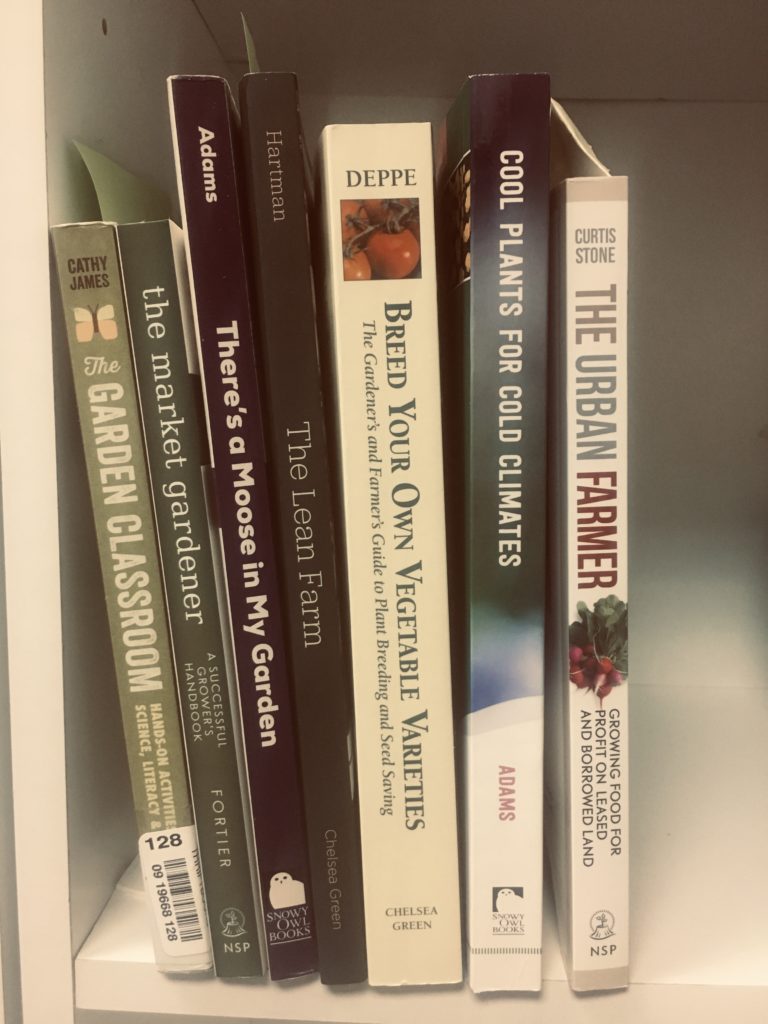If you find yourself with any extra time these days, you know, because there’s a pandemic, check out one of these inspiring garden reads. Here’s what’s on my book shelf.

Recommended garden reads
The Garden Classroom by Cathy James is an excellent resource for teachers, parents, or those involved with children. It’s intended for kids aged 4 to 8 and has all sorts of fun, creative ideas for integrating learning with the garden whatever subject is the focus (math, science, reading, and art).
Brenda Adams, is an award-winning landscape designer in Southeast, Alaska and has written two books: There’s a Moose in My Garden and Cool Plants for Cold Climates. Although you’ll need to filter her plant recommendations through the lens of an Interior gardener, the books are inspiring, beautiful, and backed by a very experienced Alaskan landscaper. They will help you whether you’re designing a new flower bed or an entire landscape.
Not only will Breed Your Own Vegetable Varieties by Carol Deppe spark your interest in saving seeds, it might also inspire you to develop a new vegetable variety. Deppe explains it’s easier and more fun to develop new varieties to suit your own desires and location. We live in a unique climate and have a relatively small population so it’s worth trying! If you’re inspired, then check out the Ester Seed Library and ‘borrow’ some seeds that other local gardeners have been adapting for Interior Alaska. The seeds are free, but you’ll be expected to save and replenish the seeds. While you’re there, look for books on this reading list at the John Trigg Ester Library or other books on sustainability and agriculture.
In Eating on the Wild Side Jo Robinson goes beyond the cursory recommendation to ‘Eat your fruits and vegetables’ and drills down to which types and varieties are most nutritious, particularly in terms of phytonutrients and sugar content. She points out that our domesticated fruits and vegetables are far less healthful than their wild ancestors. It’ll make you more discriminating when choosing what to grow and what and where to buy your produce.
The Market Gardener by Jean-Martin Fortier provides some excellent tips for planning a small-scale farm. One tip that will save you money, headaches, and time is to make your rows the same size. This makes it easy to calculate compost or fertilizer rates, rotate crops, and recycle and reuse frost cloth, plastic, and drip irrigation. Fortier tests a variety of low-tech hand tools and has a YouTube channel as well. He also has a good system for determining probability of different crop types.
I loved The Lean Farm: How to Minimize Waste, Increase, Efficiency, and Maximize Value and Profits with Less Work by Ben Hartman. Hartman applies the lean manufacturing principles developed by Toyota to his farm to turn it into a smoothly running operation. It’s a farmers answer to the popular book, The Life-changing Magic of Tidying Up by Marie Kondo. Even if you’re only a gardener and not a farmer, it might help you improve your productivity and efficiency. Actually, the philosophy can be applied to any system, job, chore, or daily task.
You live in town with a small yard. You want to have a farm, but you don’t have any money to buy land? In The Urban Farmer Curtis Stone reveals how he how farmed in a city on leased or borrowed land and ended up with more land offers than he could use. He highlights some of the considerable advantages urban farmers have compared with rural farmers.
If these books inspire you to quit your job and jump headlong into farming, read Letters to a Young Farmer, compiled by the Stone Barns Center for Food & Agriculture. Whether you’re young or old, it’s a good realty check for life as a farmer.
Previously published in the Fairbanks Daily Newsminer February 24, 2019.
